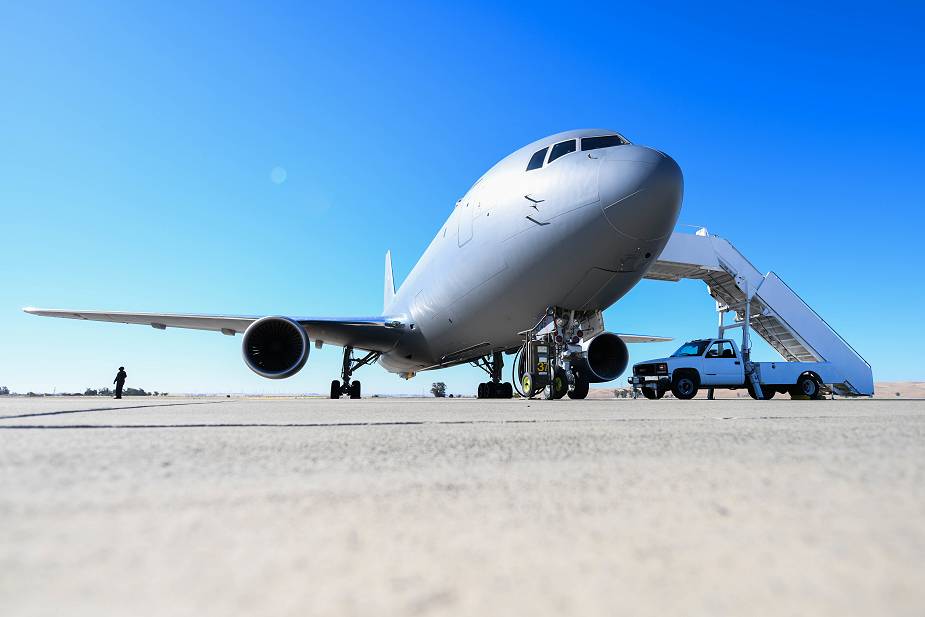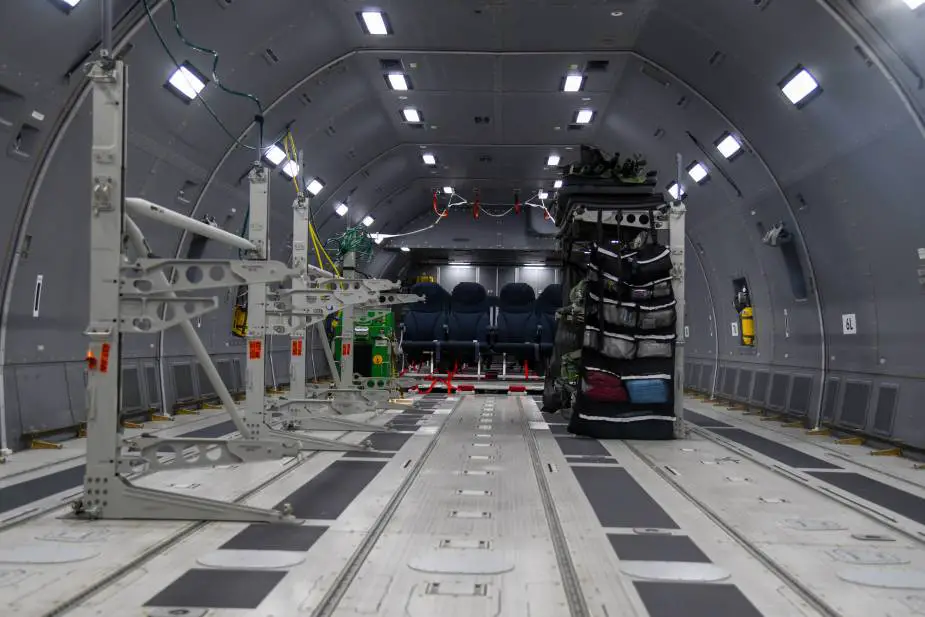According to information released by the U.S. Air Force on July 15, 2020, U.S. Air Force has conducted test capabilities of the KC-46A Pegasus aerial refueling and strategic military transport aircraft during its first aeromedical evacuation on July 10, 2020.
Follow Air Recognition on Google News at this link
 A KC-46A Pegasus assigned to McConnell Air Force Base, Kansas sits on the flightline on July 11, 2020 at Travis Air Force Base, California. (Picture source U.S. Air Force)
A KC-46A Pegasus assigned to McConnell Air Force Base, Kansas sits on the flightline on July 11, 2020 at Travis Air Force Base, California. (Picture source U.S. Air Force)
Over the course of six flights and 17 hours, the mission, which originated at Joint Base Andrews, Maryland, transited five patients and two attendees to Naval Station Norfolk, Virginia; Patrick AFB, Florida; and Travis AFB, California. The mission was evaluated by the Air Force Operational Test and Evaluation Center.
The KC-46 has undergone extensive testing this past year, led by the Air Force Operational Test and Evaluation Center, to evaluate the KC-46’s capabilities to support aeromedical evacuation. After the resolution of key discrepancies, the successful completion of the first operational mission represents a significant milestone in the aircraft’s ability to demonstrate one of its three mission sets: aerial refueling, airlift and aeromedical evacuation.
An integral factor for the successful execution of the mission was the notable patient care provided by the aeromedical evacuation team. Aeromedical evacuation plays a significant role in the nation’s globality capabilities as it provides time sensitive and mission critical patient care during transport to their home installations for follow-on care.
The total force team, which comprised of two flight nurses and three medical technicians (all qualified on the KC-46), used a syllabus that included numerous patient scenarios and configurations to guide the execution of the training.
The aircraft’s interior environmental controls proved not only to be effective but ideal for patient care. For Hampton, who has been involved in the of evaluation of the KC-46 over the past three years, witnessing the aircraft reach this major milestone is a feat he holds close to his heart.
Key features, such as increased lighting visibility, electrical power and storage capacity, allowed the team to provide quality care in the air. Since its delivery in January of 2019, there has been major headway with the aircraft’s operational capacity.

Litter stations stand assembled in the fuselage of a KC-46A Pegasus prior to patient arrival July 10, 2020, at Joint Base Andrews, Maryland. Prior to the mission, the aircraft was configured to support patient movement. A litter stanchion augmentation set container was secured on the aircraft to store the equipment required to build up to nine litter stations. (Picture source U.S. Air Force)
The KC-46 Pegasus is a military aerial refueling and strategic military transport aircraft developed by American Company Boeing from its 767 jet airliner. In February 2011, the tanker was selected by the United States Air Force (USAF) as the winner in the KC-X tanker competition to replace older Boeing KC-135 Stratotankers. The first aircraft was delivered to the Air Force in January 2019.[3] The Air Force intends to procure 179 Pegasus aircraft by 2027.
At full operational capability, the KC-46A will be able to refuel most fixed-wing, receiver-capable aircraft. The KC-46A is equipped with a refueling boom driven by a fly-by-wire control system, and is capable of fuel offload rates required for large aircraft. Its hose and drogue system adds additional mission capability that is independently operable from the refueling boom system.
The aircraft’s fuel can be pumped through the boom, drogue and wing aerial refueling pods. All KC-46As are capable of being configured with WARPs, and when equipped, the aircraft is capable of multi-point simultaneous aerial refueling. The Boom Operator controls the boom, centerline drogue and WARPs during refueling operations. The Air Refueling Operator station includes panoramic displays giving the ARO wing-tip to wing-tip situational awareness.
The KC-46A can accommodate a mixed load of passengers, aeromedical evacuation and cargo capabilities. Two high-bypass turbofans power the KC-46A to takeoff at gross weights up to 415,000 pounds. Depending on fuel storage configuration, the aircraft can carry a palletized load of up to 65,000 pounds of cargo. The KC-46A can carry up to 18 463L cargo pallets. Seat tracks and the onboard cargo handling system make it possible to simultaneously carry palletized cargo and passenger seats in a variety of combinations. The KC-46A is also equipped with a number of self-protection, defensive and communication features making it more survivable in a contested environment.
















